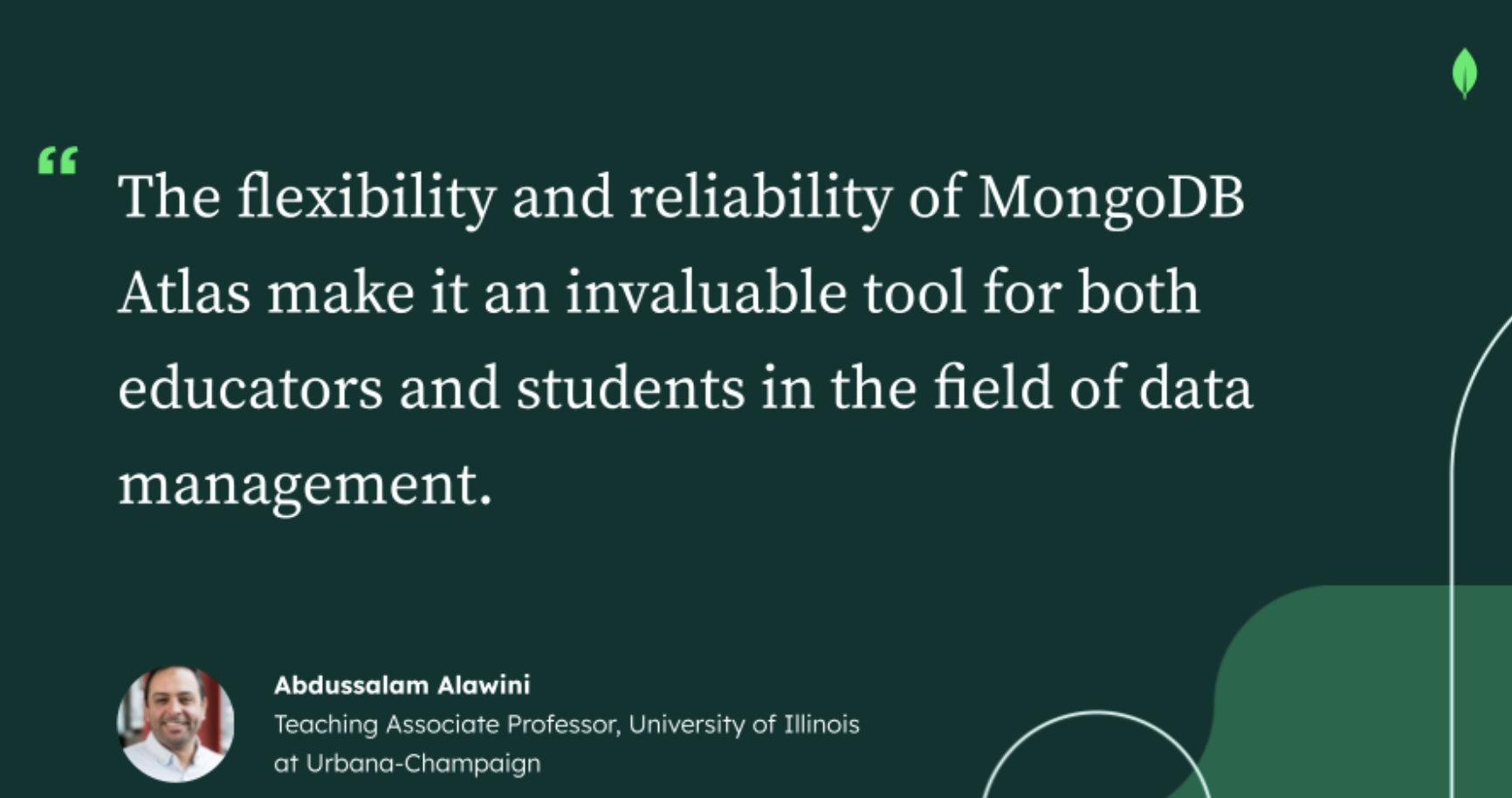In this series of interviews, we talk to students and educators around the world who are using MongoDB to make their classes more engaging and relevant. By exploring their stories, we uncover how MongoDB’s innovative platform and resources are transforming educational landscapes and empowering the next generation of tech-savvy professionals.
From creative teaching approaches to advanced classroom solutions, the MongoDB for Educators program can help you transform your classroom with cutting-edge technology and free resources. It can help you provide students with an interactive and dynamic learning environment that bridges the gap between theoretical knowledge and practical application.
The program includes a variety of free resources for educators crafted by MongoDB experts to prepare learners with in-demand database skills and knowledge. Program participants have access to MongoDB Atlas credits, curriculum materials, certifications, and membership in a global community of educators from over 700 universities.
From theory to practice: Hands-on MongoDB Teaching

Professor Abdussalam Alawini is known for his creative use of MongoDB in his courses. He heavily uses MongoDB’s free cluster to demonstrate MongoDB concepts during classes, and his students also use the free cluster for their projects, giving them hands-on experience with real-world applications.
Currently, a Teaching Associate Professor at the University of Illinois Urbana-Champaign, Professor Alawini’s research interests span databases, applied machine learning, and education. He is particularly focused on applying machine learning methods to enhance classroom experiences and education. His work also includes developing next-generation data management systems, such as data provenance, citation, and scientific management systems.
He recently received the U of I’s 2024 Campus Excellence in Undergraduate Education award, which highlights his commitment to teaching and the impact he’s had on his students. Professor Alawini is currently collaborating with colleagues on research to map how databases, data systems, data management, and related courses are taught in introductory computer science undergraduate courses worldwide.
Professor Alawini’s story offers valuable insights for educators eager to enhance their teaching and prepare students for a tech-driven future. Check out how MongoDB Atlas has revolutionized his teaching by simplifying database deployment, management, and scaling, allowing students to focus more on learning MongoDB concepts.
Tell us about your educational journey and what sparked your interest in databases.
My educational journey began with a bachelor’s degree in Computer Science from the University of Tripoli in 2002. I then spent over six years in the industry as a database administrator, lead software developer, and IT Manager. In 2011, I returned to academia and earned two master’s degrees in Computer Science and Engineering and Technology Management from Portland State University, followed by a Ph.D. in Computer Science in 2016. Subsequently, I joined the University of Pennsylvania for a two-year postdoctoral training.
My interest in databases was sparked during my time as a database administrator at PepsiCo, where I enjoyed maintaining the company’s databases and building specialized reports to improve business operations. I was particularly fascinated by database systems’ ability to optimize queries and handle millions of concurrent user requests seamlessly. This experience led me to focus my doctoral studies on building data management systems for scientific applications.
What courses are you currently teaching at the University of Illinois Urbana-Champaign?
Currently, I teach Database Systems and Data Management in the Cloud courses at the University of Illinois Urbana-Champaign. In addition, I also teach a course to University High School students to introduce them to data management and database basics. My intention with teaching databases to high schoolers is to use data management as a gateway to lower entry barriers into computing fields for non-computer science students and to recruit underrepresented minorities to computing.
What inspired you to start teaching MongoDB?
I was inspired to start teaching MongoDB after seeing several surveys indicating that it is the most used database in web development and one of the leading document-oriented databases. MongoDB offers several unique features that set it apart from other databases, including the aggregation pipeline, which simplifies data processing and transformation. Additionally, MongoDB’s flexible schema design allows for easier handling of unstructured data, and its horizontal scalability ensures robust performance as data volumes grow. These features make MongoDB an essential tool for modern web development, and I wanted to equip my students with the skills to leverage this powerful technology.
How do you design your course content to effectively integrate MongoDB and engage students in practical learning?
In all my data management courses, I focus on teaching students the concept of data models, including relational, document, key-value, and graph. In my Database Systems course, I teach MongoDB alongside SQL and Neo4J to highlight the unique features and capabilities of each data model. This comparative approach helps students appreciate the importance and applications of different databases, ultimately making them better data engineers.
In my Data Management in the Cloud course, I emphasize the system’s side of MongoDB, particularly its scalability. Understanding how MongoDB is built to handle large volumes of data efficiently provides students with practical insights into managing data in a cloud environment.
To effectively integrate MongoDB and engage students in practical learning, I use a hybrid flipped-classroom approach. Students watch recorded lectures before class, allowing us to dedicate class time to working through examples together. Additionally, students form teams to work on various data management scenarios using a collaborative online assessment tool called PrairieLearn. This model fosters peer learning and collaboration, enhancing the overall educational experience.

How has MongoDB supported you in enhancing your teaching methods and upskilling your students?
I would like to sincerely thank MongoDB for Academia for the amazing support and material they provided to enhance my course design. The free courses offered at MongoDB University have significantly improved my course delivery, allowing me to provide more in-depth and practical knowledge to my students. I heavily use MongoDB’s free cluster to demonstrate MongoDB concepts during classes, and my students also use the free cluster for their projects, which gives them hands-on experience with real-world applications.
MongoDB Atlas has been a game-changer in my teaching methods. As a fully managed cloud database, it simplifies the process of deploying, managing, and scaling databases, allowing students to focus on learning and applying MongoDB concepts without getting bogged down by administrative tasks. The flexibility and reliability of MongoDB Atlas make it an invaluable tool for both educators and students in the field of data management.
Could you elaborate on the key findings from your ITiCSE paper on students’ experiences with MongoDB and how these insights can help other educators?
In my ITiCSE paper, we conducted an in-depth analysis of students’ submissions to MongoDB homework assignments to understand their learning experiences and challenges. The study revealed that as students use more advanced MongoDB operators, they tend to make more reference errors, indicating a need for a better conceptual understanding of these operators. Additionally, when students encounter new functionalities, such as the $group operator, they initially struggle but generally do not repeat the same mistakes in subsequent problems. These insights suggest that educators should allocate more time and effort to teaching advanced MongoDB concepts and provide additional support during the initial learning phases. By understanding these common difficulties, instructors can better tailor their teaching strategies to improve student outcomes and enhance their learning experience.
What advice would you give to fellow educators who are considering implementing MongoDB in their own courses to ensure a successful and impactful experience for their students?
Implementing MongoDB in your courses can be highly rewarding. Here’s some advice to ensure success:
-
Foundation in Data Models: Teach MongoDB alongside other database types to highlight unique features and applications, making students better data engineers.
-
Utilize MongoDB Resources: Leverage support from MongoDB for Academia, free courses from MongoDB University, and free clusters for hands-on projects.
-
Practical Learning: Use MongoDB Atlas to simplify database management and focus on practical applications.
-
Focus on Challenges: Allocate more time for advanced MongoDB concepts. Address common errors and use tools like PrairieLearn that capture students’ interactions and learning progress to identify learning patterns and adjust instruction.
-
Encourage Real-World Projects: Incorporate practical projects to enhance skills and relevance.
-
Continuous Improvement: Gather feedback to iteratively improve course content and share successful strategies with peers. MongoDB is always evolving so make sure to stay tuned with their updates and new features.
These steps will help create an engaging learning environment, preparing students for real-world data management.
Apply to MongoDB for Educators program and explore free resources for educators crafted by MongoDB experts to prepare learners with in-demand database skills and knowledge.